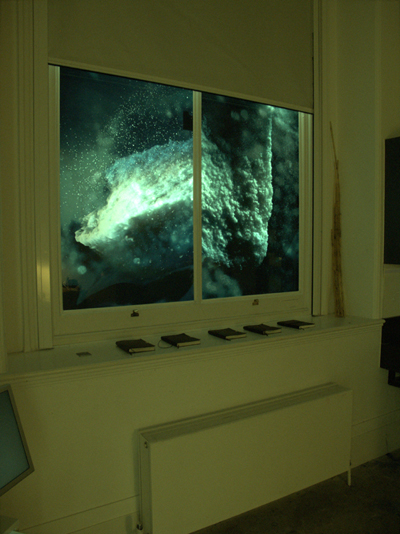



‘Living’ is the result of a six month residency at the V&A by Christian Kerrigan – from January to June 2010 – and it is part of The 200 Year Continuum. The 200 Year Continuum is the title of a project by the same artist that explores the relationship between nature and technology. Interestingly ‘Living’ was exhibited in the same space where it was created: in the digital studio of the V&A. This was a small room with dim light and crowded with rarities. It felt like one was penetrating the secretive and magical space of experimentation of some sort of mad professor.

Once in the space my gaze wandered around a series of oddities. On the right, a table full of raw materials; in the middle of the room, a fish tank with algae floating in high pH waters; on a wall, a real time video projection showing the evolution of the algae; on a different wall, a slide projection showing some drawings; in some shelves, notebooks with notes by the artist; above the sink, chemical products piled up on a shelf; and on each and every window a semi-transparent drawing. No explanations, no titles, nothing. It’s you and the objects. Luckily Christian Kerrigan was always about, meeting visitors and discussing the work. We started looking at the materials on the table. Christian told us those were unprocessed rocks and crystals that he used as the starting point for his drawings. He scanned pieces of amber, moss, fiber glass, volcanic rock or resin and produced a model using 3D software. Then he manipulated that model to create his drawings and printed them on semitransparent paper. He eventually placed them on the windows of the space. This routine allowed him to explore the different stages of a process that makes real matter and virtual space intermingled. It is a practice that explores where the process of creation begins, and what it does to reality. ”The drawings, he tells us, become extensions of the physical material which I started with.” Although we have become accustomed to discuss the hybridity of our nature-culture, the way Christian carefully interwove materialities and virtualities was very evocative. The fact that the drawings were placed on the windows gave yet another layer of complexity to the mixture. The colours of the printings morphed natural light into a hybrid light turning the atmosphere of the room into a creative and ongoing process.

Next I wondered about that mysterious fish tank in the middle of the room where algae lived (and died) in high pH waters: Encased Nature. Apparently the algae reacted to the elevated pH creating a protective coat that eventually killed them. At the bottom of the tank: a graveyard of coated dead algae showed the consequences. I instantly loved the idea. Again an experiment about the hybridity of natural and controlled habitats. I thought it was a particularly dystopic illustration of the environment we inhabit where control works on the conditions of the environment, dictating the way reality unfolds. This is an emerging tendency in our most-discussed societies of control, what has come to be called soft control. And we could take it even further, and see it as a great illustration of today’s climate of fear. In such a habitat, the threat has become virtual and all-pervasive, it has become poisonous in itself, just like high pH. The nightmare of security measures that this artificially produced environment justifies links quite well to the ‘lethal-protective’ coat. What this allegory leaves out, though, is the power of imagination! The capacity of conditions to be turned around, the potential for intervention and deviation from the pre-programmed chain of (re)actions. The idea of projecting a live video recording on the wall was to intensify the experience and highlight the importance of mediation. As Christian argued, we are now more used to experience nature through a lens than to experience its presence. However, the quality of the footage seemed to work against the intentions of the artist and rather than intensifying the experience of that enclosed nature, it tended to obscure it. The particular texture that the webcam gave to the recordings turned that hybrid habitat almost into an abstract movie. On a different corner there was another video projection made out of a series of drawings. Interestingly they had been created using a ‘living technology’ and recorded at a nano-scale. For Living Drawing, the artist had collaborated with Martin Hanczyc from the Department of Physics and Chemistry at the University of Southern Denmark. They had manipulated some protocells that inhabited chemical gradients and reacted to ultraviolet light. When UV light was applied to the fiberglass where these protocells ‘lived’ their motion left traces of colour that were recorded. This technique, although still in its early stages, allowed the artist to ”explore the spontaneous event of drawing by using organic systems”, he told us. Kerrigan’s rather cryptic exhibition proved to be an inspiring and very personal exploration of the blurring between nature and culture in its absolute physicality. Paying particular attention to the materiality of the creative process, from the composition of the materials used, to the chemistry of the drawing process or to the laws of electromagnetism that inform light in its interaction with his work, his methodologies show a passion for unfolding reality in its many scales. His work is that of someone who’s starting to explore rather than someone who’s making an assertion; it is tentative rather than conclusive, it is interesting for its questions rather than its answers. However, even if sometimes vague, it is at points pleasingly dark and sometimes inspiringly intense.